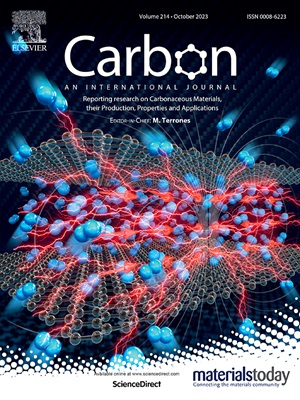用阳离子聚合物接枝氧化石墨烯功能化,增强对阴离子染料和病毒的吸附
IF 10.5
2区 材料科学
Q1 CHEMISTRY, PHYSICAL
引用次数: 0
摘要
氧化石墨烯(GO)是一种表面含有大量含氧官能团的片状碳材料。人们已将 GO 作为重金属和有机化合物的吸附剂进行了广泛研究。然而,针对带负电荷材料的有效策略尚未确立。本研究旨在合成 GO 和阳离子聚合物的复合材料,以选择性地吸附带负电荷的材料;这种方法面临的一个挑战是 GO 和阳离子聚合物之间的强静电相互作用,这可能会导致聚集。本研究采用接枝穿透法解决了这一问题。首先用烯丙胺修饰 GO,引入一个可聚合的位点,然后通过自由基聚合将聚合物共价键合到 GO 表面,从而有效地防止了聚集。吸附实验表明,GO-聚合物复合材料可选择性地吸附甲基橙等阴离子染料。病毒吸附测试表明,与原始 GO 相比,GO 的性能明显提高。这些结果强调了受控表面改性和电荷操作在优化 GO 吸附性能方面的关键作用。这项研究为合成 GO 阳离子聚合物复合材料提供了一种简单有效的方法,有助于开发先进的水净化应用材料。本文章由计算机程序翻译,如有差异,请以英文原文为准。

Grafting-through functionalization of graphene oxide with cationic polymers for enhanced adsorption of anionic dyes and viruses
Graphene oxide (GO) is a sheet-like carbon material with abundant oxygen-containing functional groups on its surface. GO has been extensively studied as an adsorbent for heavy metals and organic compounds. However, effective strategies for negatively charged materials have yet to be established. This study aimed to synthesize composites of GO and cationic polymers for the selective adsorption of negatively charged materials; a challenge in this approach is the strong electrostatic interactions between GO and cationic polymers, which can lead to aggregation. This study addresses this issue by employing the grafting-through method. GO was initially modified with allylamine to introduce a polymerizable site, followed by radical polymerization to covalently bond polymers to the GO surface, effectively preventing aggregation. Adsorption experiments demonstrated that the GO-polymer composite selectively adsorbs anionic dye, such as methyl orange. Virus adsorption tests showed significantly enhanced performance compared to pristine GO. These results emphasize the critical role of controlled surface modification and charge manipulation in optimizing the adsorption performance of GO. This study establishes a simple and effective approach for synthesizing GO-cationic polymer composites, contributing to the development of advanced materials for water purification applications.
求助全文
通过发布文献求助,成功后即可免费获取论文全文。
去求助
来源期刊

Carbon
工程技术-材料科学:综合
CiteScore
20.80
自引率
7.30%
发文量
0
审稿时长
23 days
期刊介绍:
The journal Carbon is an international multidisciplinary forum for communicating scientific advances in the field of carbon materials. It reports new findings related to the formation, structure, properties, behaviors, and technological applications of carbons. Carbons are a broad class of ordered or disordered solid phases composed primarily of elemental carbon, including but not limited to carbon black, carbon fibers and filaments, carbon nanotubes, diamond and diamond-like carbon, fullerenes, glassy carbon, graphite, graphene, graphene-oxide, porous carbons, pyrolytic carbon, and other sp2 and non-sp2 hybridized carbon systems. Carbon is the companion title to the open access journal Carbon Trends. Relevant application areas for carbon materials include biology and medicine, catalysis, electronic, optoelectronic, spintronic, high-frequency, and photonic devices, energy storage and conversion systems, environmental applications and water treatment, smart materials and systems, and structural and thermal applications.
 求助内容:
求助内容: 应助结果提醒方式:
应助结果提醒方式:


